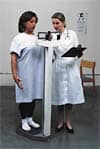For patients who snore but don’t have obstructive sleep apnea, they could be suffering from issues in the nose—and there are treatment options that help avoid surgery.
Patients who snore may assume the cause is obstructive sleep apnea (OSA). But when a patient’s home or in-lab test comes back without evidence of OSA, patients can be frustrated and wonder what the cause of their snoring really is. Primary snoring, or simple snoring, due to nasal obstruction or inflammation may be the answer to that question. For people who do not have sleep apnea but want treatment for their snoring, noninvasive options are available to assist with nasal breathing.
Raj C. Dedhia, MD, MSCR, assistant professor, otolaryngology/HNS & sleep medicine, at Emory University Hospital Midtown, says there are two types of reasons for poor nasal breathing: structural and inflammatory. “Structural causes include things like septal deviation. Inflammatory causes are usually things like allergies and other environmental factors.”
So how does nasal breathing relate to snoring? Dedhia says breathing through your nose is actually the optimal way to breathe during sleep. “Mouth breathing has a couple of problematic effects on the course of the airflow,” he says. “When you breathe through your mouth, your jaw tends to fall back, which causes your tongue to fall back, and even your palates are relaxed more. That combo makes it more likely for the patient to have an obstruction. When the airflow goes through the mouth and hits that back wall, there isn’t a smooth transition like there is in the back of the nose. So there’s more turbulence that can generate snoring sounds.”
Nicholas A. Michalak, cofounder and CEO of SomniFix, maker of mouth strips that keep the mouth closed and promote nasal breathing, says, “We generally do a snore test to help people determine where their snores originate. You can do it quite easily. In a comfortable, reclined sleeping position, try to create a snore noise with your mouth open. Then close your mouth and try to create the same snore noise. If you are only able to snore with an open mouth, then you are an open mouth snorer. If you are able to snore with the mouth closed, then you are a nose snorer.”
Peggy Powers, RRT, clinical education manager at oral appliance maker Oventus Medical, says that when the nasal airway becomes partially or completely blocked, there is an increase in nasal resistance that spurs several changes. “There is an increase in negative pressure in the oral airway, which could possibly result in soft palate collapse. The patient must start mouth breathing at this point, and this will continue to increase the negative pressure in the airway resulting in the airway walls collapsing and causing snoring,” she says.
Behrouz Hariri, cofounder and CEO of SmartNora, an inflating pillow accessory for snorers, says, “The most common reason we snore is that when we fall asleep, our neck and throat muscles relax, which tightens our airways and causes the vibrations in our throat. The solution that SmartNora has come up with is that by gently raising and lowering your pillow, your neck muscles are stimulated, and smooth, silent breathing resumes.”
Is Nose Breathing Superior?
Is it always better to breathe through the nose rather than the mouth during sleep? Michalak argues that nose breathing is far superior to mouth breathing at almost all times. “There are, of course, exceptions like intense physical exercise, when you must breathe through your mouth,” he says. “But unless you are unable to nose breathe, you should strive to breathe through the nose as much as possible. Your nose’s primary function is to breathe. Nose breathing warms and humidifies inhaled air and creates copious amounts of nitric oxide, a vasodilator that improves carbon dioxide-oxygen exchange.”
Michalak says excessive mouth breathing can have serious implications. “In children, habitual mouth breathing is correlated with malocclusion, retrognathic jaw development, and smaller respiratory airways,” he says. “Mouth breathing also leads to discomforts such as dry mouth, sore throat, nasal congestion, and chronic sinus issues.”
Shane Duncan, vice president of global sales and marketing at Rhinomed, which makes nasal dilators, says, “The nose is part of the filtration and humidification system of the upper airway; the more we breathe through the nose, the more filtered or humidified air gets to the lungs. This assists with more efficient gas exchange assisting with oxygenation and helping promote deeper sleep. Also, the more we breathe through our nose (and close our mouths), the more those tissues at the back of the throat move away from the airway reducing or eliminating snoring.”
Otolaryngologist Patrick Byrne, MD, MBA, FACS, and partner Clay Andrews, co-founder of AssistENT, makers of the N-Stent nasal breathing aid, explain the science. “There is always more resistance when breathing through the nose than through the mouth—but this is by design, as it gives more time for the lungs to extract oxygen from the air and eliminate carbon dioxide as waste. This keeps the pH of the blood balanced and helps keep cells all over the body functioning,” they say. “It would take a conscious effort to replicate these effects of nasal breathing through the mouth. Mouth breathing also leads to water loss, causing the dry mouth feeling many are familiar with during exercise. This can also have consequences for dental health, leading to gingivitis and accelerate cavity development.”
Nonsurgical Options Abound
Dedhia says there are two major options for nonsurgical treatment for simple snoring due to nasal blockage or congestion. “First, I would recommend basic medications—things that help reduce congestion,” he says. “If people have allergies, a nasal steroid can be helpful. If people don’t have allergies and still have nasal congestion, something like a decongestive spray can be helpful, but it’s not really a good long-term solution given the risk for rebound congestion. Second, nasal dilator strips or nasal cones are also helpful for people who are looking for nonsurgical treatments.”
SomniFix’s Michalak says anything that improves muscle tone in the mouth and neck will help improve breathing and reduce snoring. “Weight loss is particularly helpful, especially if your BMI [body mass index] is over 32,” he says. “Another option is orofacial myofunctional therapy, as the exercises are excellent for improving muscle tone and oral rest posture.” Michalak says his company’s mouth strips work to stop snoring by “gently holding the lips closed to direct airflow through the nose.”
Oventus’ Powers says, “Oral appliances are typically not recommended for a patient with nasal obstruction,” but adds that the Oventus O2Vent Airway Management Device was designed to take mouth breathing and nasal obstruction into account. “The Oventus O2Vent, while providing mandibular advancement, also incorporates an airway into the oral device allowing the patient to breathe either through their nose or through the device, therefore decreasing the negative pressure swings in the airway and eliminating snoring,” she says.
Weight loss, positional therapy that keeps patients off their backs, and avoiding alcohol/sedatives/certain medications help too, she says, though these methods alone may not completely eliminate snoring.
The N-Stent, a new product by AssistENT, is designed to replicate the effect of functional nasal surgery without its downsides (such as risk and cost). “The N-Stent breathing aid…is designed to fit stably in the nostril with no external components and without producing a noticeable aesthetic change in the nose, rendering it completely invisible to onlookers. Rather than using simple cones and rods, N-Stent’s eccentric geometries are informed by a large set of maxillofacial CT data, which has allowed us to engineer a dilator whose curves align perfectly with typical nasal anatomy to maximize comfort. The design itself is informed by the natural nasal cartilage and the grafts surgeons place when reconstructing the nose to improve airflow,” say Byrne and Andrews.
Patients who are interested in these therapies might be wondering how long they should try a nonsurgical therapy before determining whether it works.
“I tell patients 5 days,” says Dedhia. “And most people will typically say that their congestion is a lot better by then and the snoring is either improved or stopped.”
Michalak says, “Users should expect an acclimation period of up to a week or two. SomniFix Mouth Strips generally have a 5-night acclimation period. They will work from the first night if properly applied; however, removal during sleep is common while users become used to them.”
Powers says, “Some patients state after the first night they feel wonderfully refreshed in the morning, and for other patients it may take a full 30 days of consistently using the therapy before they notice a result. If a healthcare provider is using a screening tool such as the Epworth Sleepiness Scale, there should eventually be an improvement in the score. If not, then changes in the therapy should be addressed.”
Looking Ahead
Dedhia says that he hopes in the future more people will be able to receive a diagnosis. “In my experience, about 50% of patients who have snoring without apnea are treated successfully to improve snoring,” he says. “But that means 50% don’t improve with nasal treatment alone. It can be hard to distinguish who will have nasal obstruction and who won’t.”
Michalak says he would like to see a greater focus on patient comfort. “We strongly believe that non- or minimally invasive products are the future. Products that require the least amount of acclimation or training for the end user will do very well in building customer bases. We also hope to see more use of combination therapy between OTC [over the counter] devices,” he says.
Powers says education is key—for the patient, the patient’s family, and the patient’s bed partner. “It’s important to understand that snoring is more than just an annoyance. If left untreated, there is a whole host of diseases and conditions that will manifest such as high blood pressure, heart disease, and diabetes,” she says. “There are several proven treatment options available. Find the one that works best for you and then don’t give up. There are constantly new and innovating ideas that are coming to market for the treatment of snoring and obstructive sleep apnea. Also, there is improved communication and collaboration among healthcare providers such as sleep physicians, dentists, primary care physicians, etc.”
If someone is struggling with primary snoring and doesn’t have OSA, nasal obstruction or congestion could be the root cause. Before sending them out the door, consider recommending a few solutions to their simple snoring.
Dillon Stickle is associate editor of Sleep Review.





Feels like my nasal cavity is blocked, I do suffer from allergies.